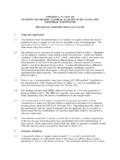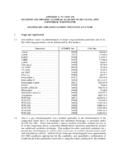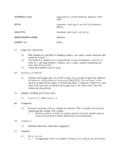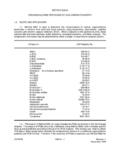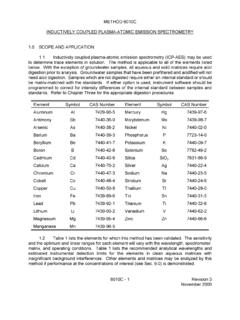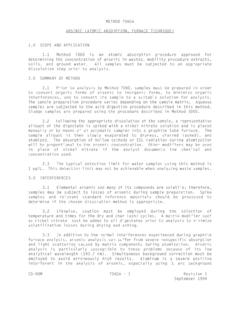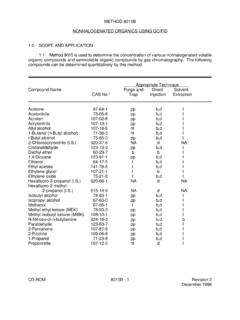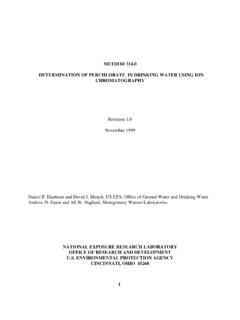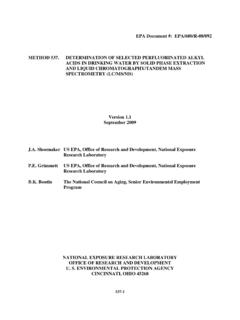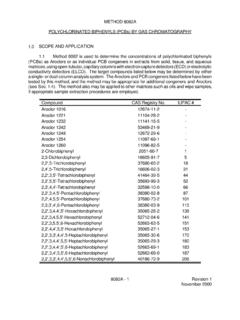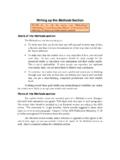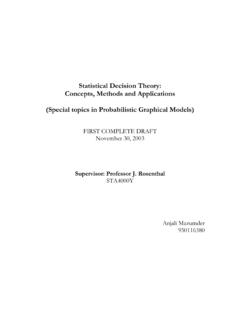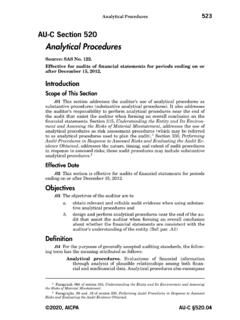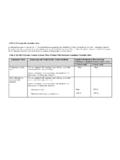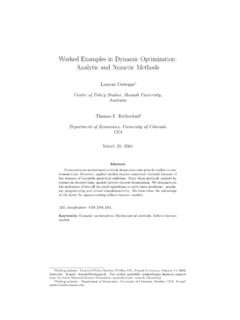Transcription of Method 1613 Tetra- through Octa-Chlorinated Dioxins and ...
1 Method 1613 Tetra- through Octa-Chlorinated Dioxins and Furans by IsotopeDilution HRGC/HRMSO ctober Environmental Protection AgencyOffice of WaterEngineering and Analysis Division (4303)401 M Street , 20460 AcknowledgmentsThis Method was prepared under the direction of William A. Telliard of the Engineering andAnalysis Division within the EPA Office of Water. This document was prepared under EPAC ontract No. 68-C3-0337 by DynCorp Environmental Services Division with assistance fromits subcontractor Interface, Method has been reviewed by the Engineering and Analysis Division, Protection Agency, and approved for publication. Mention of trade names orcommercial products does not constitute endorsement or recommendation for 1613 October 1994iiiIntroductionMethod 1613 was developed by the United States Environmental Protection Agency's Officeof Science and Technology for isomer-specific determination of the 2,3,7,8-substituted, Tetra- through Octa-Chlorinated , dibenzo-p- Dioxins and dibenzofurans in aqueous, solid, and tissuematrices by isotope dilution, high resolution capillary column gas chromatography(HRGC)/high resolution mass spectrometry (HRMS).
2 Questions concerning this Method or its application should be addressed TelliardUS EPA Office of WaterAnalytical Methods StaffMail Code 4303401 M Street, SWWashington, 20460202/260-7120 Requests for additional copies should be directed to:Water Resource Center Mail Code RC-4100401 M Street, SWWashington, 20460202/260-7786 or 202/260-2814 Method 1613 October 19941 Method 1613, Revision BTetra- through Octa-Chlorinated Dioxins and Furans by IsotopeDilution and Method is for determination of tetra- through Octa-Chlorinated dibenzo-p- Dioxins (CDDs) and dibenzofurans (CDFs) in water, soil, sediment, sludge, tissue, and othersample matrices by high resolution gas chromatography/high resolution massspectrometry (HRGC/HRMS). The Method is for use in EPA's data gathering andmonitoring programs associated with the Clean Water Act, the Resource Conservationand Recovery Act, the Comprehensive Environmental Response, Compensation andLiability Act, and the Safe Drinking Water Act.
3 The Method is based on a compilationof EPA, industry, commercial laboratory, and academic methods (References 1-6). seventeen 2,3,7,8-substituted CDDs/CDFs listed in Table 1 may be determined bythis Method . Specifications are also provided for separate determination of2,3,7,8-tetrachloro-dibenzo-p- dioxin (2,3,7,8-TCDD) and 2,3,7,8-tetrachloro-dibenzofuran(2,3,7,8 -TCDF). detection limits and quantitation levels in this Method are usually dependent on thelevel of interferences rather than instrumental limitations. The minimum levels (MLs)in Table 2 are the levels at which the CDDs/CDFs can be determined with nointerferences present. The Method Detection Limit (MDL) for 2,3,7,8-TCDD has beendetermined as pg/L (parts-per-quadrillion) using this GC/MS portions of this Method are for use only by analysts experienced withHRGC/HRMS or under the close supervision of such qualified persons.
4 Each laboratorythat uses this Method must demonstrate the ability to generate acceptable results usingthe procedure in Section Method is "performance-based". The analyst is permitted to modify the Method toovercome interferences or lower the cost of measurements, provided that all performancecriteria in this Method are met. The requirements for establishing Method equivalencyare given in Section modification of this Method , beyond those expressly permitted, shall be considereda major modification subject to application and approval of alternate test proceduresunder 40 CFR and of MethodFlow charts that summarize procedures for sample preparation, extraction, and analysisare given in Figure 1 for aqueous and solid samples, Figure 2 for multi-phase samples,and Figure 3 for tissue 16132 October samples (samples containing less than 1% solids)
5 Stable isotopicallylabeled analogs of 15 of the 2,3,7,8-substituted CDDs/CDFs are spiked into a 1 Lsample, and the sample is extracted by one of three Samples containing no visible particles are extracted with methylenechloride in a separatory funnel or by the solid-phase extraction techniquesummarized in Section The extract is concentrated for Samples containing visible particles are vacuum filtered through a glass-fiber filter. The filter is extracted in a Soxhlet/Dean-Stark (SDS) extractor(Reference 7), and the filtrate is extracted with methylene chloride in aseparatory funnel. The methylene chloride extract is concentrated andcombined with the SDS extract prior to sample is vacuum filtered through a glass-fiber filter on top of a solid-phase extraction (SPE) disk. The filter and disk are extracted in an SDSextractor, and the extract is concentrated for , semi-solid, and multi-phase samples (but not tissue) The labeledcompounds are spiked into a sample containing 10 g (dry weight) of containing multiple phases are pressure filtered and any aqueous liquidis discarded.
6 Coarse solids are ground or homogenized. Any non-aqueous liquidfrom multi-phase samples is combined with the solids and extracted in an SDSextractor. The extract is concentrated for and other tissue The sample is extracted by one of two Soxhlet or SDS extraction A 20 g aliquot of sample is homogenized, anda 10 g aliquot is spiked with the labeled compounds. The sample is mixedwith sodium sulfate, allowed to dry for 12-24 hours, and extracted for 18-24 hours using methylene chloride:hexane (1:1) in a Soxhlet extractor. Theextract is evaporated to dryness, and the lipid content is HCl digestion A 20 g aliquot is homogenized, and a 10 g aliquot isplaced in a bottle and spiked with the labeled compounds. Afterequilibration, 200 mL of hydrochloric acid and 200 mL of methylenechloride:hexane (1:1) are added, and the bottle is agitated for 12-24 extract is evaporated to dryness, and the lipid content is extraction, Cl -labeled 2,3,7,8-TCDD is added to each extract to measure the374efficiency of the cleanup process.
7 Sample cleanups may include back-extraction with acidand/or base, and gel permeation, alumina, silica gel, Florisil and activated carbonchromatography. High-performance liquid chromatography (HPLC) can be used forfurther isolation of the 2,3,7,8-isomers or other specific isomers or congeners. Prior to thecleanup procedures cited above, tissue extracts are cleaned up using an anthropogenicisolation column, a batch silica gel adsorption, or sulfuric acid and base back-extraction,depending on the tissue extraction procedure 1613 October cleanup, the extract is concentrated to near dryness. Immediately prior to injection,internal standards are added to each extract, and an aliquot of the extract is injected intothe gas chromatograph. The analytes are separated by the GC and detected by a high-resolution ( 10,000) mass spectrometer. Two exact m/z's are monitored for each individual CDD/CDF is identified by comparing the GC retention time and ion-abundance ratio of two exact m/z's with the corresponding retention time of an authenticstandard and the theoretical or acquired ion-abundance ratio of the two exact m/z's.
8 Thenon-2,3,7,8 substituted isomers and congeners are identified when retention times andion-abundance ratios agree within predefined limits. Isomer specificity for 2,3,7,8-TCDDand 2,3,7,8-TCDF is achieved using GC columns that resolve these isomers from the analysis is performed using selected ion current profile (SICP) areas, in oneof three the 15 2,3,7,8-substituted CDDs/CDFs with labeled analogs (see Table 1), theGC/MS system is calibrated, and the concentration of each compound isdetermined using the isotope dilution 1,2,3,7,8,9-HxCDD, OCDF, and the labeled compounds, the GC/MS systemis calibrated and the concentration of each compound is determined using theinternal standard non-2,3,7,8-substituted isomers and for all isomers at a given level ofchlorination ( , total TCDD), concentrations are determined using responsefactors from calibration of the CDDs/CDFs at the same level of quality of the analysis is assured through reproducible calibration and testing of theextraction, cleanup, and GC/MS are given in the glossary at the end of this and , reagents, glassware, and other sample processing hardware may yield artifactsand/or elevated baselines causing misinterpretation of chromatograms (References 8-9).
9 Specific selection of reagents and purification of solvents by distillation in all-glasssystems may be required. Where possible, reagents are cleaned by extraction or solventrinse. cleaning of glassware is extremely important, because glassware may not onlycontaminate the samples but may also remove the analytes of interest by adsorption onthe glass should be rinsed with solvent and washed with a detergent solutionas soon after use as is practical. Sonication of glassware containing a detergentsolution for approximately 30 seconds may aid in cleaning. Glassware withMethod 16134 October 1994removable parts, particularly separatory funnels with fluoropolymer stopcocks,must be disassembled prior to detergent detergent washing, glassware should be rinsed immediately, first withmethanol, then with hot tap water.
10 The tap water rinse is followed by anothermethanol rinse, then acetone, and then methylene not bake reusable glassware in an oven as a routine part of cleaning. Bakingmay be warranted after particularly dirty samples are encountered but should beminimized, as repeated baking of glassware may cause active sites on the glasssurface that will irreversibly adsorb prior to use, the Soxhlet apparatus should be pre-extracted withtoluene for approximately three hours (see Sections through ).Separatory funnels should be shaken with methylene chloride/toluene(80/20 mixture) for two minutes, drained, and then shaken with pure methylenechloride for two materials used in the analysis shall be demonstrated to be free from interferences byrunning reference matrix Method blanks initially and with each sample batch (samplesstarted through the extraction process on a given 12-hour shift, to a maximum of 20samples).
